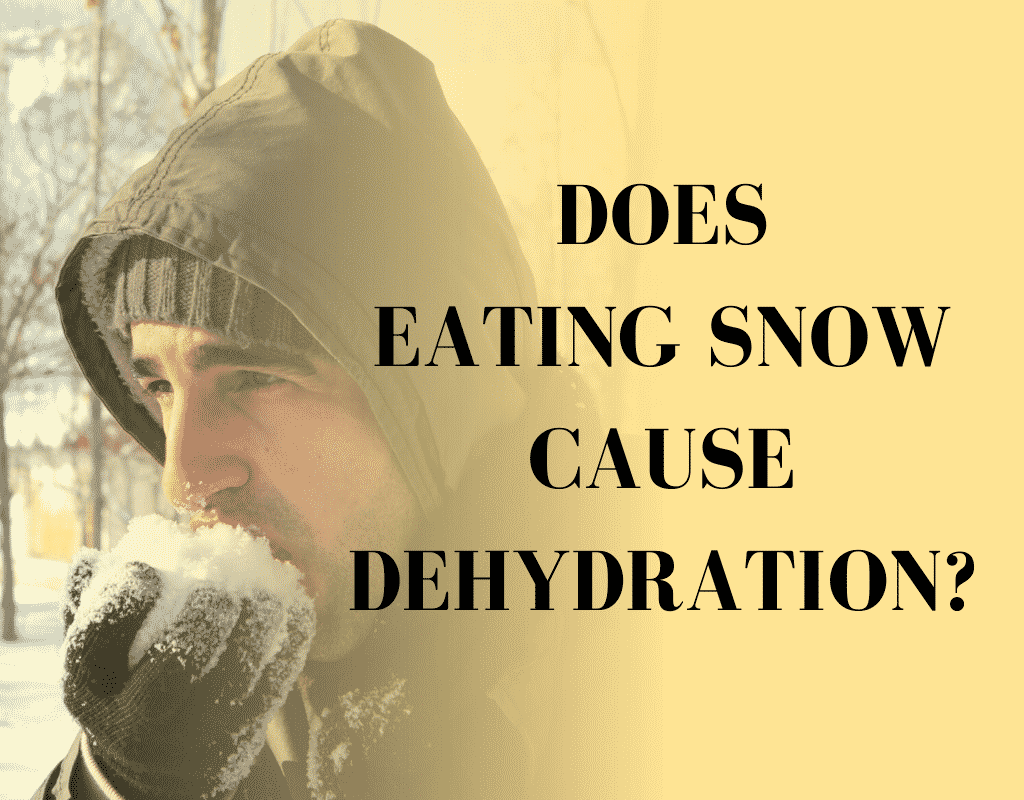Every person has eaten a mouthful of snow at some point in their life. Eating snow feels like you’re taking in water, but are you actually absorbing the melted water? Or is something else going on in your body? Does eating snow make you more dehydrated?
Eating snow will make you more dehydrated than drinking nothing at all. It forces your body into overdrive to melt the snow and regulated internal body temperature. This leads to burning water faster than your body can absorb it which leads to increasing dehydration levels.
That’s why you should always melt and purify snow into drinking water to avoid dehydration. In the rest of this post I’ll explain why eating snow causes dehydration, discuss dehydration in cold weather, and explain how to melt snow to create safe drinking water.
Does Eating Snow Make You More Dehydrated?
Eating snow in the winter isn’t the same as drinking water. Your body needs to consume water that’s in a liquid state and snow is a solid. So your body has to work to heat up snow and melt it down to a liquid for it to enter your cells and organs.
So does eating snow make you dehydrated? Yes eating snow will make you dehydrated if that’s your only source of water. Your body needs water in liquid form so it needs to melt snow before it can be absorbed into your cells and organs. The human body has to work harder to heat and melt snow, which leads to burning water faster than it can take it in.
Here are all of the reasons why eating snow can lead to dehydration.
- Your Body Can’t Absorb Snow Without Melting: The human body can’t absorb snow into its cells/organs in solid form so it needs to melt it first. Your natural body temperature will melt the snow at first, but it will need to increase your internal body temperature to regulate against the cold snow.
- Eating Snow Makes The Body Work Harder: Every bite of snow you take cools down your body temperature and your body will need to work harder to regulate the temperature. Increasing your body temperature causes your cells/organs to burn more water faster than they can absorb. If your body can’t keep up with the temperature regulation it will eventually lead to hypothermia, which is far more dangerous than being slightly dehydrated.
- Snow Is Less Dense Than Water: The average person needs to drink 1-2 liters of water per day and even more if you’re exercising. Snow is less dense than water so you need a lot of snow to get 2 liters of water into your body. It depends on the density of the packed snow, but 10″ of fresh snow is the equivalent of 1″ of water.
- Snow Contains Bacteria and Viruses: Eating snow is just like drinking straight out of a dirty river. It’s filled with bacteria and viruses that need to be filtered or purified before consumption. Consuming bacteria/viruses can lead to diarrhea, nausea, and vomiting, which increases the likelihood of dehydration. Fresh snow is cleaner than older packed snow, but it’s still better to boil the snow before consumption.
It’s pretty clear that eating snow can lead to dehydration after reading that list. It doesn’t matter how much snow you eat. You will always use up more water than your cells can absorb. That leads to an endless cycle of using up more water than you can absorb, which quickly leads to dehydration.
Plus it’s almost impossible to eat enough snow to fulfill your daily water needs since snow is less dense than water. Eating a gallon of snow would be the equivalent of drinking 12oz of water, which can lead to dehydration if you’re not taking in additional water.
There are times where snow is your only option to rehydrate your body in backpacking and camping situations. In those situations you’ll have to melt snow before it’s consumed to prevent further dehydration. Boiling snow also kills bacteria and viruses, which can also lead to dehydration. So it’s never a smart idea to eat snow
I’ll explain each of these topics in detail and explain how to melt snow below, but lets start off by talking about dehydration in cold weather.
Dehydration In Cold Weather
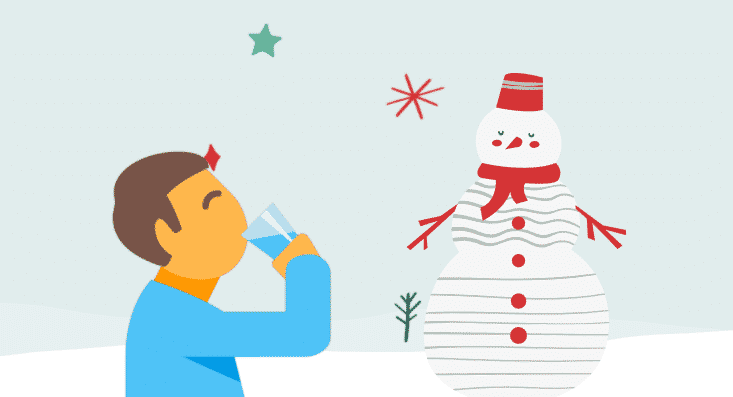
Your body needs water to function properly. It’s just like an engine needing oil, your uses water in all it’s cells, organs, and tissues to help regulate temperature and maintain important bodily functions. You probably already know this, but your bodies made up of 75% water. So dehydration can cause serious health problems if you don’t get it under control.
Most people assume that you can only get dehydrated in the summer, but cold weather dehydration is a serious problem among campers and backpackers. There’s a serious misconception that hydration needs drop in the winter, but that’s completely wrong. You might not lose as much water through sweat, but you still lose water every time you breath and urinate. That can lead to cold weather dehydration if you’re not careful.
You still need to take in 2 liters of water to keep your organs and cells functioning properly. Failing to meet your water needs leads to muscle cramps, fatigue, dizziness, and death if it goes on long enough.
Winter dehydration is very common and needs to be considered when camping, hiking and hunting in snowy wilderness. Focus on prevention and know how to find a backcountry water source in an emergency. You shouldn’t rely solely on melting snow when there are other remote water sources available. Here are the most common causes of winter dehydration.
- Wearing Extra Clothing: Wearing extra clothing helps regulate temperature in the cold, but it also increases sweat production. Your body has to work harder to regulate body temperature and deal with the extra clothing weight.
- Sweat Evaporates Quickly In Cold Air: Sweat evaporates faster in cold weather. It might seem like you’re not sweating in cold weather, but the sweats actually evaporating faster than your clothing can absorb water. You also need to avoid wearing too many layers that can lead to excess sweating as your body tries to cool down.
- Increased Respiratory Fluid Loss: As temperatures drop you will lose more water through your breath to make up for the increased stress trying to regulate temperatures. Every time you breathe in the water a little bit of water is released in your breath. That’s why you can see water vapor in the air as you breathe. Seeing your breath is condensation from the temperature difference between your internal temperature and the outside air.
- Poor Backcountry Water Sources: It’s easy to get into a bad situation if you’re drinking from unfiltered/unpurified water sources. Every water source has bacteria and viruses trapped in the water that could lead to illness and sever dehydration (diarrhea and vomiting). That’s why you should always boil snow or filter flowing water in remote camping areas. Just understand that water filters can freeze causing permanent damage to the filter which allows bacteria to pass through
- Underestimating Water Needs: In the summer, most of us take active steps to prevent dehydration. We add electrolytes to our drinking water and make sure we take in more water than usual during exercise. Most of those preventative steps are ignored in cold weather since we don’t realize how much water we’re burning going through on a daily basis.
Eating Snow Leads To Dehydration Since Your Body Can’t Absorb It
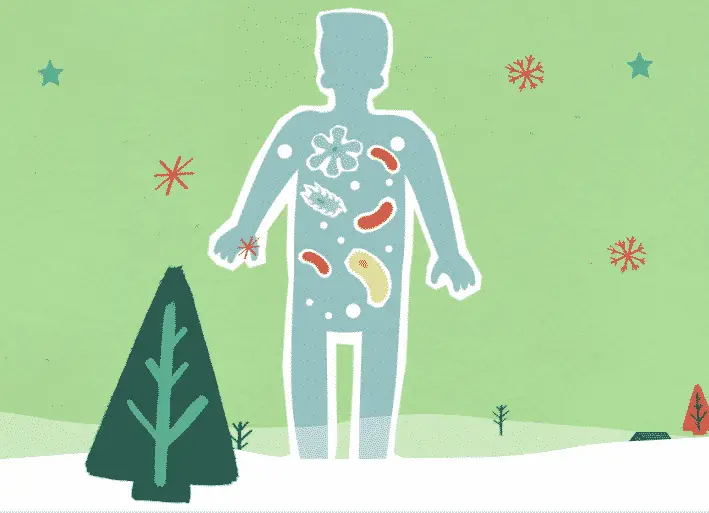
The human body is unable to absorb solid snow. Your internal body heat will slowly melt the snow as you eat it, but that requires a lot of work. The body has to turn up heat production to make up for the drop in temperature from eating snow. I’ll explain why increasing the work load is such a big problem in the next section.
As I mentioned above, eating snow actually increases your dehydration levels. That’s why I always try to plan my backpacking trips around water sources. You can usually break up ice to get at the water below, but I’ve occasionally ran into situations where snows the only available water source. So how do you avoid dehydration if snows your only water source on a remote camping or backpacking trip?
You have to find a way to melt snow to get so your body can absorb it. That usually means bringing in extra fuel and a camping stove, but you can also boil water over a campfire. Remember that waters denser than snow so it takes a lot of snow (10/1 ratio fresh snow or 4/1 dense packed snow) to get a decent supply of clean drinking water. That means you’ll be going through a lot of camping fuel so plan ahead.
How to Melt Snow For Drinking Water
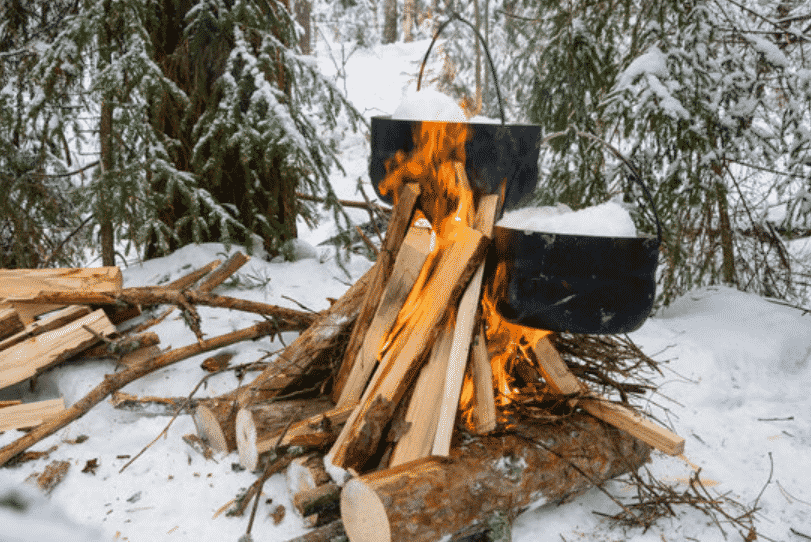
Melting snow to make drinking water is a fairly straightforward process, but it’s a lot of work. You will go through a lot of fuel to melt snow so it’s always better to start out with liquid water.
There is one thing that most people don’t realize. You need to start off with a little bit of liquid water in the bottom of your pot or else the snow won’t melt. Here’s how to melt snow to make clean drinking water.
- Gather Up Your Snow: You need to gather a lot of snow to melt it down to drinking water. A 5 gallon buckets worth of snow is enough to provide one days worth of drinking water. You may need less with heavily packed snow, but try to get freshly fallen snow to prevent contamination.
- Use A Big Pot: Bring at least a 2 liter pot or larger to melt snow and a separate pot for collecting snow.
- Start Off With Seed Water: Start out with enough water to cover the bottom of your pot to prevent scorching.
- Turn Up The Heat: Use a pot skirt or build a wind block to increase the efficiency of your flame and turn up the temperature. The only time you would need to use the maximum heat setting is on extremely cold days.
- Slowly Add In Snow: Add a little bit of snow at a time to slowly melt your snow. The key is to never allow the snow to completely melt before adding more in. This keeps the temperature near the melting point and avoids wasting fuel.
- Pour Out Melted Water As The Pot Fills: As your pot starts to fill, pour the melted water into a storage container and replace it with fresh snow. Keep repeating this process until you have 2-3 liters of water.
- Don’t Forget To Purify The Water: Since you never reached boiling temperatures you’ll still need to find a way to kill the bacteria, viruses, and protozoa. Boiling water works, but it uses a lot of fuel. I recommend using a water filter since it removes dirt and sediment. UV Purifiers and Chemical purifiers also work, but most people like to run the water through a filter to improve the taste.
If you have lots of fuel and decide to boil the water make sure you aerate the water. Boiled water tastes flat so aerating it will improve the taste. Just move the water back and forth between your pot and storage container a few times. This adds oxygen to the water and will significantly improve the taste.
Only melt enough snow for a single days use since it freezes fast. I recommend using insulated water bottles and insulated hydration bladder sleeves to prevent freezing. Use up as much water as you can before bed and dump out most of the extra water.
Just make sure you store a bottle of water in your sleeping bag to keep it from freezing overnight. I like to heat up a Halgene bottle and store it in my sleeping bag overnight. This preheats your sleeping bag before bed and your body heat keeps it from freezing so you have fresh seed water to melt snow in the morning.
Eating Snow Makes The Body Work Harder
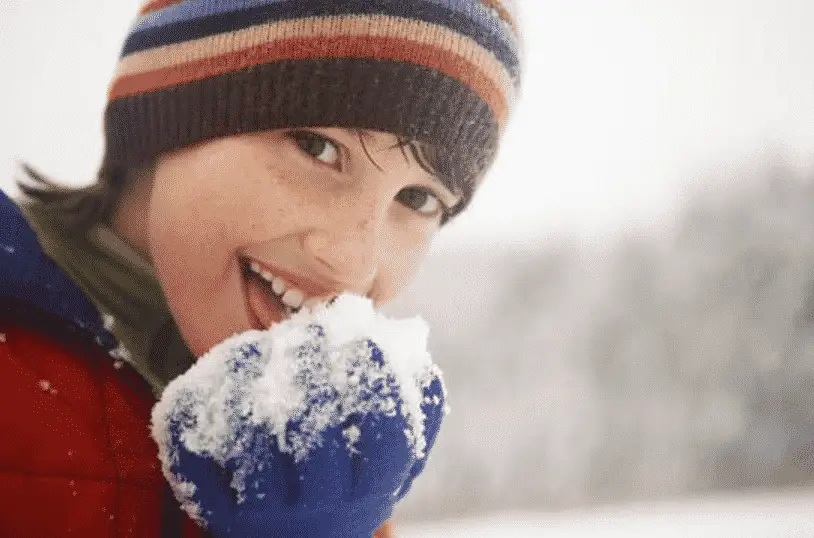
Eating snow decreases your internal body temperature. Your body responds to the temperature drop by working harder to regulate internal temperatures. The body has to melt solid snow into its liquid form while maintaining constant body temperatures to prevent hypothermia.
This leads to your cells/organs ramping up the temperature to reach homeostasis and using up more water than it usually would. You absorb a little bit of the melted snow, but end up using more water than you can absorb.
That’s not a big deal if you only eat a small amount of snow, but it can easily lead to dehydration with large quantities. To make matters worse, it takes a lot of melted snow to get a small amount of drinking water.
If you ignore the amount of water lost by your body maintaining its temperature you would have to eat 5 gallons of snow to get a days worth of drinking water. It would be almost impossible to consume that much snow and you would definitely end up with hypothermia (low body temperature).
Snow Is Less Dense Than Water
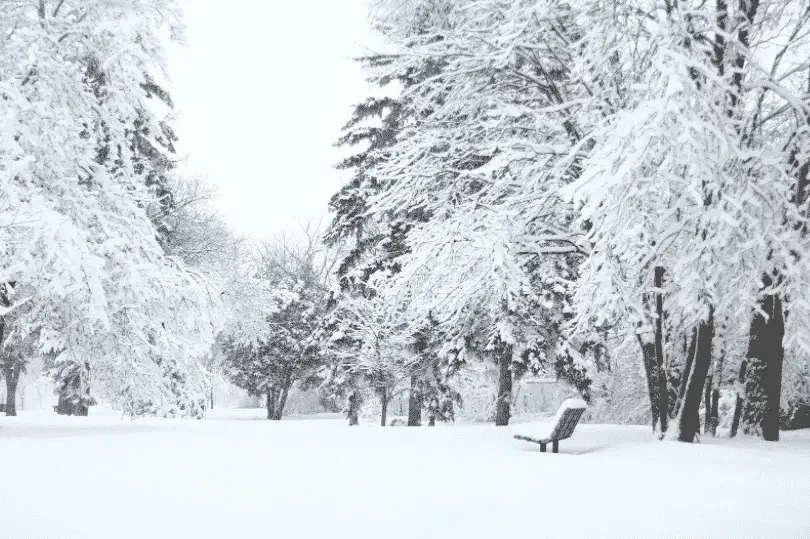
Water is always much denser than water. It takes 10 inches of snowfall to get the same amount of water as 1 inch of rain. So a standard 5 gallon bucket of snow would yield about 1/2 gallon (less than 2 liters) of snow.
The average person goes through 1-2 liters of water per day and even more if they’re exercising (up to 4 Liters). If you don’t replace all of that water you will eventually start to get dehydrated, cramp up, feel dizzy, and sever dehydration can be fatal. It would be impossible to eat 5-10 gallons of snow in a day without going into hypothermia.
That’s why you need to either melt snow or find a liquid water source to filter or purify. Melting snow is a pain so finding alternative water sources is a much better option. Look for flowing water that resists freezing and ice that’s thin enough to smash through to the fresh water below.
To make matters worse our body goes through more water in cold weather to maintain constant temperatures. Every time you breathe water vapors are released into the air. That’s why you can see your breath in the winter. That’s water vapor that’s condensing in the air with every breath you take.
It might not feel like you’re sweating on a 10 mile hike in cold weather, but you definitely are. Water evaporates faster in cold weather so your shirt clothing might not get wet, but there’s more sweat than you think. Throw on a few extra layers and it compounds the problem. Your body sweats to cool off, it quickly evaporates, and you never stop sweating.
Snow Contains Bacteria and Viruses Leading To Illness and Severe Dehydration
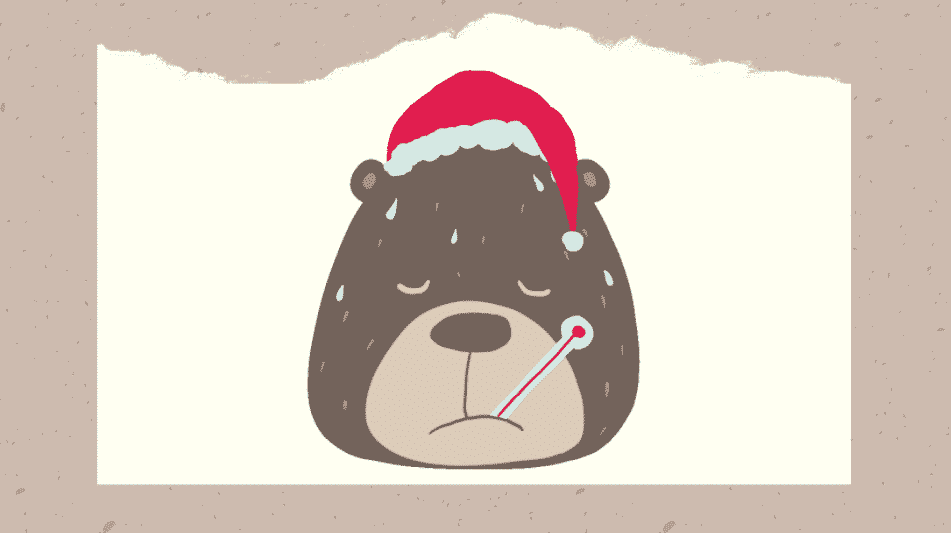
Every person has eaten a little bit of snow in our lives. Eating fresh snow rarely leads to problems, but older packed snow is filled with bacteria and possibly viruses (depending on where you are). That’s why you should always purify or filter snow melt before drinking it.
Eating snow that contains bacteria, viruses, and protozoa can lead to serious health issues. It will upset your stomach causing nausea, diarrhea, vomiting, fever, and sweating. All of those side effects increase your chances of developing severe dehydration.
It’s just like having a stomach bug or the flu. You need to take in lots of fluids and replace your electrolytes. If you’re unable to do that you’re body won’t be able to absorb water faster than you go through it.
